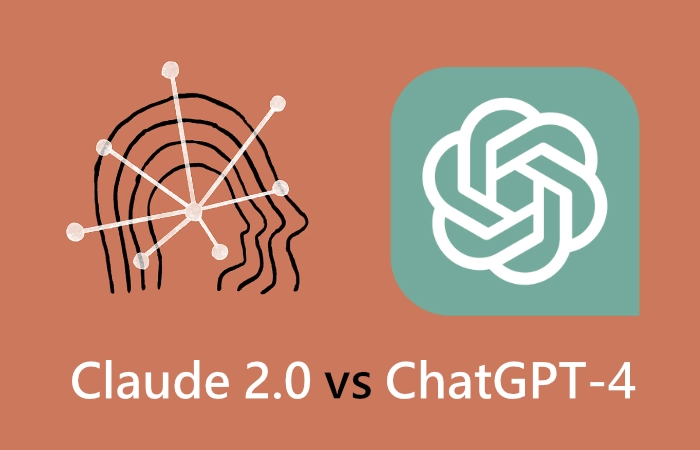In the rapidly evolving landscape of AI language models, two contenders stand out for their blend of capability and safety: Anthropic’s Claude 2 and OpenAI’s GPT-4. While both models aim to provide a wide range of functionalities, from answering questions to generating content, they diverge significantly in their approaches to safety, scalability, and application. Claude 2, developed by a company founded by ex-OpenAI employees, focuses heavily on creating a “helpful, harmless, and honest” AI, whereas GPT-4, OpenAI’s latest offering, leans more towards advanced reasoning capabilities and a broader scope of applications, including multimodal functionalities.
Claude 2, although not as powerful as ChatGPT-4, has carved a niche for itself by prioritizing safety and ethical considerations. It employs various safety guardrails and a second AI model, Constitutional AI, to mitigate issues related to bias and toxicity. This makes Claude 2.0 an attractive choice for organizations and platforms that prioritize safety and ethical AI usage. On the other hand, GPT-4’s selling points include its advanced reasoning capabilities and a more extensive range of functionalities. Trained on Microsoft Azure’s AI-optimized infrastructure, it outperforms most other models, including its predecessor ChatGPT, in standardized tests and professional benchmarks.
Both models have found their way into real-world applications, with Claude 2 being integrated into services like Notion AI and DuckDuckGo’s DuckAssist, and GPT-4 available through ChatGPT Plus and as an API for developers. As Claude 2.0 aims for a global expansion, and GPT-4 continues to break new ground in creative and technical tasks, the competition between these two models represents the broader contest between safety and capability in the AI industry.
What is Claude 2.0
Claude 2.0 represents an ambitious venture in the landscape of AI development, conceived and nurtured by Anthropic, an AI research company with a focus on safety. Founded in 2021 by former OpenAI employees, Anthropic’s agenda is clear: to engineer AI models that are not only efficient but also secure and ethical. Claude 2.0 is the bedrock upon which this vision is being realized.
First and foremost, Claude 2.0 is an integral component of Anthropic’s AI chatbot, Claude. It is designed to be a multi-functional entity capable of writing, answering questions, and collaborating with users. While it may not match the capabilities of GPT-4, Claude 2.0 has proven its mettle by outperforming most other AI models in standardized tests. This places it in a unique position in the AI market, where it combines moderate computational power with heightened safety measures.
Claude 2 vs ChatGPT-4
Other articles you may find of interest on the subject and comparisons of Claude 2 AI large language model :
This safety-centric approach is evident in Claude’s integration into various platforms. In early 2023, Claude was incorporated into popular services such as Notion AI, Quora’s Poe, and DuckDuckGo’s DuckAssist. These strategic partnerships not only extend Claude’s functionalities but also underscore Anthropic’s commitment to providing safe and efficient AI solutions.
The Claude chatbot has been released in open beta in the U.S. and the U.K., with global expansion plans on the horizon. The primary aim here is to fulfill Anthropic’s vision of a “helpful, harmless, and honest” large language model. To this end, the company employs multiple layers of safety guardrails designed to minimize issues related to bias, inaccuracy, and unethical behavior. An additional layer of scrutiny comes from Anthropic’s second AI model, Constitutional AI, which works in tandem with Claude 2.0 to discourage toxic or biased responses.
The safety-first approach extends beyond mere programming. Anthropic’s pre-release process includes “red teaming,” a methodology where researchers deliberately attempt to provoke unsafe responses from Claude. This allows the team to identify vulnerabilities and implement safety mitigations proactively.
Being a public benefit corporation, Anthropic has the leeway to prioritize safety over profits. This positioning also allows them to advocate for AI safety while maintaining commercial competitiveness. The company’s CEO believes that for Anthropic to be a genuine advocate for AI safety, it must also be a market competitor that influences others to raise safety standards. In line with this, Anthropic has taken steps to engage with policymakers. They have briefed U.S. President Joe Biden at a White House AI summit and committed to providing the U.K.’s AI Safety Taskforce with early access to their models.
Claude 2.0 is engineered to handle up to 100K tokens per prompt, which is equivalent to around 75,000 words. It is trained on data up to early 2023, making it relevant and updated. Claude 2.0 serves as a beacon in AI development, illuminating the path towards safer, more ethical AI solutions. With its moderate capabilities yet robust safety measures, Claude 2.0 stands as a testament to Anthropic’s dedication to aligning technological prowess with ethical responsibility.
What is ChatGPT-4
GPT-4 stands as a pinnacle in OpenAI’s ongoing efforts to advance the field of deep learning. As the most sophisticated system from OpenAI to date, GPT-4 has made a significant leap over its predecessors, particularly ChatGPT, in terms of reasoning capabilities, safety measures, and utility across various applications.
At its core, GPT-4 is a large multimodal model capable of handling both text and image inputs, emitting text outputs that often exhibit human-level performance on professional and academic benchmarks. This expansive ability makes it a versatile tool used by organizations worldwide to innovate across different sectors, from content creation to technical problem-solving.
The training infrastructure behind GPT-4 is equally impressive. Utilizing Microsoft Azure’s AI-optimized supercomputers, OpenAI ensures that GPT-4 is not just powerful but also globally accessible. Azure’s capabilities allow the system to be delivered to users around the world efficiently, further democratizing access to advanced AI.
ChatGPT Plus
When it comes to availability, GPT-4 is accessible through ChatGPT Plus and also as an API for developers. This dual accessibility ensures that both individual users and organizations can integrate GPT-4 into their workflows or services, making it a versatile tool for a wide array of tasks. From generating and editing creative content like songs and screenplays to performing complex problem-solving, GPT-4 is more creative and collaborative than ever before.
One of the standout features of GPT-4 is its advanced reasoning capabilities. Following the developmental trajectory from GPT to GPT-3, OpenAI has continued to invest in leveraging more data and computational power to create a language model that scores higher in approximate percentiles among test-takers. This level of sophistication enables GPT-4 to solve difficult problems with greater accuracy, aided by its broader general knowledge base.
Safety
Safety and alignment have been central to GPT-4’s development. OpenAI spent six months ensuring that GPT-4 is safer and more aligned with human values. Compared to GPT-3.5, GPT-4 is 82% less likely to respond to requests for disallowed content and 40% more likely to produce factual responses, based on internal evaluations. While it still has limitations, such as social biases and susceptibility to adversarial prompts, OpenAI is committed to continuous improvements.
In casual conversations, the distinction between GPT-3.5 and GPT-4 might be subtle. However, the difference becomes evident when tasks increase in complexity. GPT-4 is more reliable and capable of handling nuanced instructions, making it a superior choice for more sophisticated requirements.
To empirically understand the capabilities and limitations, OpenAI conducted tests on various benchmarks, such as simulating exams originally designed for humans. These evaluations were carried out without specific training for these exams, making the results representative of the model’s generalized capabilities.
GPT-4 serves as a monumental step in OpenAI’s mission to scale up deep learning. With its advanced reasoning capabilities, safety measures, and versatility, GPT-4 is shaping up to be an indispensable tool in the advancement of AI applications across various domains.
Filed Under: Guides, Top News
Latest Aboutworldnews Deals
Disclosure: Some of our articles include affiliate links. If you buy something through one of these links, Aboutworldnews may earn an affiliate commission. Learn about our Disclosure Policy.







